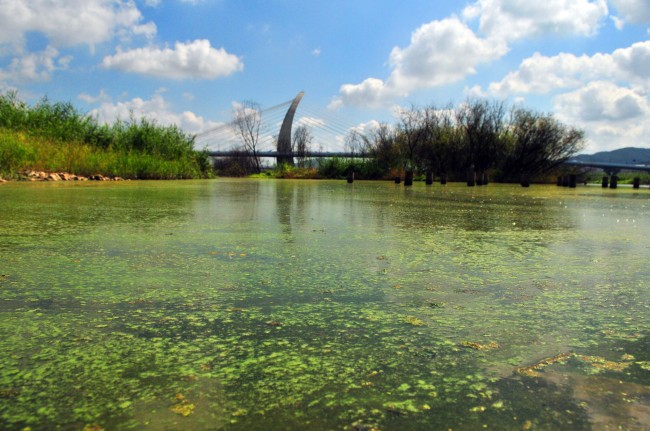The land and environment ministries pledged to jointly respond to algal blooms, including emergency releases of water from upstream dams.
The Ministry of Environment and the Ministry of the Land, Infrastructure and Transport have been at odds over the cause of green tides, which began to spread in major rivers late last month.
In a press release Wednesday, the two authorities said they agreed to jointly take measures to protect drinking water, including opening the Nakdonggang dam gates, should green tides reach a dangerous level. A panel of government and civilian experts will decide on the timing and amount of discharge.
A task force of officials from the environment, land and agricultural ministries will be established under the Prime Minister’s Office to fight the algal blooms expected to peak in mid-late August.
Their conflict was triggered last week when Environment Minister Yoon Seong-kyu became the first government official to admit that the massive project led by the Land Ministry of damming and dredging four major rivers could be responsible for recent algal blooms.
 |
Algae blooms are spotted for the first time this year in Geumgang River in North Jeolla Province on Thursday. (Yonhap News) |
The government has categorically denied the link claimed by independent scientists and activists for years.
During a Cabinet meeting, the veteran environmental bureaucrat reported to President Park Geun-hye that the weirs and mini-dams installed on the rivers slowed the water flows, contributing to the spread of green algal blooms.
“Algal bloom is caused by various factors including water temperature, nutrients, decreased flows. Especially the dams built for the four-river project worsened the phenomenon,” the minister was quoted as saying.
On July 30, the accumulation of algae in Nakdan Reservoir reached this year’s peak level of 22,384 cells per milliliter ― a third of the record-breaking number of 69,882 cells per milliliter last August.
The Environment Ministry added fuel to the dispute last Friday by revealing that the previous administration had tried to skim off muck with hundreds of public servants ― an alternative measure for water discharge that could be seen as a denial by the ministry that the reservoirs are fit for purpose.
The Ministry of Land, Infrastructure and Transport fired back saying algal blooms were an annual occurrence and further study was needed to determine whether they were related to the four-river project.
On Monday, President Park Geun-hye sent a stern warning to the two ministries.
“Ministries can have their own stance about policies, but they should have a single view before making it public,” Park said during a chief secretary meeting.
Algal blooms are caused by a number of factors, including an excess of nutrients, particularly phosphorus and nitrogen; high temperatures; and extended periods of weak water circulation.
However, opening the floodgates to release the green tide would be a makeshift measure, said Park Chan-kun, a civil engineering professor at Kwandong University.
“Even if they open the floodgates, the green muck will go downstream and accumulate there,” Park explained.
“The most optimal plan would be to open the gates 24/7. But that will show that the Lee administration’s restoration plan was just a waste o←→f money.”
Some species of cynobacteria, such as microcystis, can produce toxins within their cell structure and affect drinking water.
Officials say microcystis has not been found at water treatment plants connected to the Nakdong, which serves as a source of drinking water to some 3 million people in Daegu and nearby areas.
By Suk Gee-hyun (
monicasuk@heraldcorp.com)





![[Exclusive] Hyundai Mobis eyes closer ties with BYD](http://res.heraldm.com/phpwas/restmb_idxmake.php?idx=644&simg=/content/image/2024/11/25/20241125050044_0.jpg)
![[Herald Review] 'Gangnam B-Side' combines social realism with masterful suspense, performance](http://res.heraldm.com/phpwas/restmb_idxmake.php?idx=644&simg=/content/image/2024/11/25/20241125050072_0.jpg)

